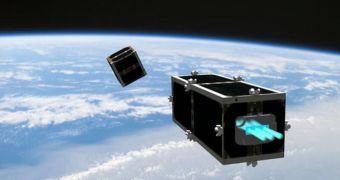The CleanSpace One project, currently under development in Switzerland, could finally address an issue that has been growing increasingly complex over the last few years. The endeavor's goal is to create satellites that are able to clean Earth's orbits of debris.
Astronomers estimate that as many as 500,000 pieces of junk are currently orbiting around the planet at different altitudes, traveling at speeds up to thousands of miles per hour. They pose a huge navigational and operational hazard to working satellites, and the International Space Station (ISS).
This has been made increasingly clear lately. The ISS has had to maneuver out of harm's way several times over the past month, changing its orbit when pieces of debris threatened to come too close to it.
Debris ranges in size and shape from spent rocket stages to very small chips of paint and other similar components. Regardless of size, each of them can pass clean through satellites, as if they weren't even there, Space reports.
What Swiss scientists are aiming for is creating a debris cleaner that will be able to clean up at least some of this flying debris. The proposed CleanSpace One prototype is a spacecraft only 30 centimeters (12 inches) long, and 10 centimeters (4 inches) wide.
The first such satellite could be orbited around 2015. Its method of operations is rather crude, but effective. Once it encounters a piece of space debris, it latches on to it via a robotic arm, and then plunges into the atmosphere, carrying the junk with it.
For the first trials, project managers want to target the Swisscube picosatellite or the Tisat spacecraft, both of which have long since expired. Both are very small, with a volume of only 61 cubic inches (1,000 cubic centimeters).
The team in charge of developing the orbital janitors is based at the Swiss Federal Institute for Technology (EPFL) Swiss Space Center (SSC), in Lausanne. CleanSpace One-class spacecraft will be able to hook up with debris traveling at speeds up to 17,500 miles (28,000 kilometers) per hour.
“The [main] challenge will be having a deployment either of a robotic arm or a deployment of a mechanism that will embrace or grab exactly Swisscube,” explains Muriel Richard, a scientist at EPFL.
“Space agencies are increasingly finding it necessary to take into consideration and prepare for the elimination of the stuff they're sending into space. We want to be the pioneers in this area,” SSC Director Volker Gass concludes.

 14 DAY TRIAL //
14 DAY TRIAL //